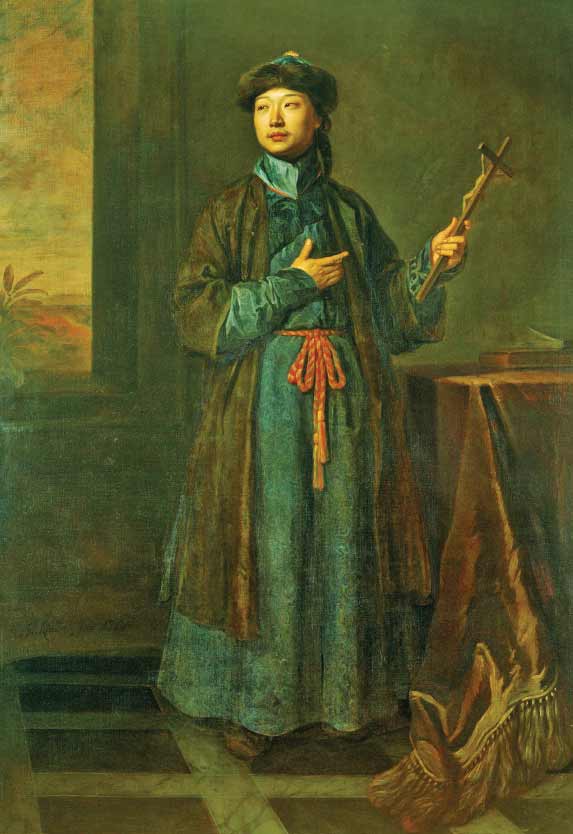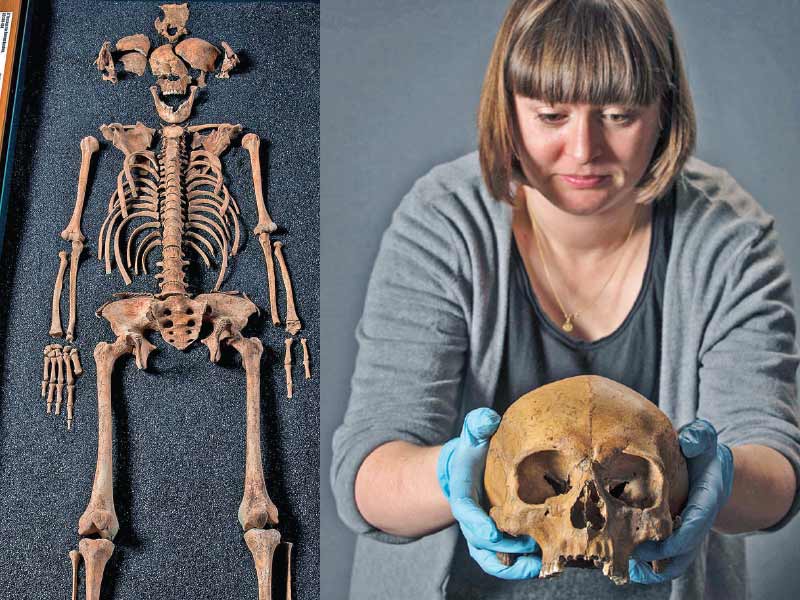Chinese pathfinders paved the way in UK hundreds of years ago


With Chinese students flowing into the United Kingdom in ever-increasing numbers, Chinese entrepreneurs and investors eagerly snapping up businesses and landmarks in British city centers, and Chinese tourists suddenly in the majority at many of the UK's attractions, Britons might think Chinese people have only recently noticed their country.
But an exhibition at the University of Oxford's St Hugh's College reminds us that visits by Chinese people to the British Isles began far earlier than many people realize, and that the motivations for those historic interactions are largely the same as those that draw Chinese people to the UK today.
Shen Fuzong, the First Chinese Visitor to Oxford, which runs until Dec 14 in the Dickson Poon University of Oxford China Centre, tells the story of the first documented Chinese visitor to England, his six weeks in Oxford, and his immortalization in paint at the request of King James II,which all happened way back in 1687.
Shen, who has also been called Shen Fo-tsung and an array of Anglicized names, including Michael Alphonsius Shen Fu-Tsung, Michel Sin, and Michel Chin-fo-tsoung, was born in today's Nanjing, in East China's Jiangsu province, the son of a physician and had been a scholar and government bureaucrat before converting to Catholicism and undertaking his epic journey to Europe alongside a Jesuit priest called Philippe Couplet,which the pair undertook in an attempt to get the Catholic church to increase its interest in Asia.
David Helliwell, from the Faculty of Oriental Studies at Oxford University, who is the Bodleian Library's curator of Chinese collections and who is currently cataloguing the pre-modern Chinese collections of books within Oxford's libraries, said many people at the time of the visit seem to have viewed Shen more as a curiosity than a serious source of information about China, but his trip to England was groundbreaking, nonetheless.
"Locally, in Oxford, he achieved a lot," Helliwell said. "He was here for six weeks, during which time he had extensive talks with Thomas Hyde, who was Bodleian's librarian at the time. Hyde learned a lot from him about China and the Chinese language. The Bodleian already had a collection of about 100 Chinese books at that time, but nobody knew what they were about. Shen explained to Thomas Hyde what they were, and Hyde wrote the explanations, in Latin, on each book. Then, he made a list of them, and this was included in a famous printed catalogue, which was published in 1697. So,Shen was actually the first person to catalogue Chinese books in the Bodleian Library."
Shen taught Hyde, an accomplished linguist and authority on Hebrew, Arabic, and Sanskrit, some Chinese, making him the first Englishman to receive lessons in written and spoken Chinese. Shen did not speak English and so the pair communicated in the lingua franca of the time: Latin. Shen also gave Hyde a crash course on Chinese culture, in the form of written lessons that are now preserved in the British Library.
"People were more interested in what he looked like than what he did or what he knew," Helliwell said, alluding to the fact that many scholarly men of the time failed to do what Hyde did and make the most of their interactions with him.
Shen met the king of England, James II, while in the UK, making such a mark on him that the king commissioned Sir Godfrey Kneller to paint a portrait of Shen that subsequently hung in the king's personal quarters. The portrait is the star attraction in the exhibition about Shen Fuzong at St Hugh's College and is accompanied by books and artifacts. The display is being supported by an array of conferences and seminars about Shen and his visit, which began with Shen and Couplet leaving Macao in 1681. The pair visited today's Belgium, Italy, and France before arriving in England. While in Italy, they visited Rome and Couplet sought the pope's permission to conduct Catholic religious services in China in the Mandarin language, instead of the usual Latin.
But despite Shen's contribution to the development of one of the world's most famous libraries and his role in education and cultural understanding, many people today are unaware of him.
"Most people in England, even highly educated ones, have never heard of him," Helliwell lamented. "He visited England in a century when overseas contact was becoming more and more frequent, and when there was an interest in exotic things from the New World and the East. I'm afraid the interest in Shen at that time was mostly of this kind."
Shen left England in 1688 and went to Lisbon to further study the Catholic religion before leaving for China. He died as the result of a fever, in 1691,while aboard a ship, somewhere off the coast of the African country Mozambique.
While we now know he was hugely important in the history of Chinese people in the UK, he was not the first person from China to travel to the British Isles.Two skeletons unearthed in London in September 2016 during excavations of a Roman cemetery push the date of the first interaction between Chinese people and Britain back a further 1,300 years, to between the 2nd and 4th centuries AD

Rebecca Redfern, curator of human osteology at the Museum of London, said the skeletons, which were found close to the south end of London Bridge and that were identified as likely being of Chinese origin,clearly show ties between the UK and Asia stretch much farther back than people had previously imagined.
"This is absolutely phenomenal," she told BBC Radio 4's The World at One shortly after the discovery was made. "This is the first time in Roman Britain we've identified people with Asian ancestry."
The Independent newspaper reported at the time that the discovery suggested trade was taking place between Rome and China that went far beyond the extremities of the famous Silk Road trade route,and that the two massive world powers of the time likely had more interaction than historians had previously thought.
Writing in The Journal of Archaeological Science, Redfern explains: "The expansion of the Roman Empire across most of western Europe and the Mediterranean, led to the assimilation and movement of many ethnically and geographically diverse communities.Its power and wealth meant that it also had trade connections for raw materials and products, such as silk, throughout Europe, Africa, and also to the east, including India and China.Many people travelled, often vast distances, for trade or because of their occupation."
Archaeologists and historians believe the two Chinese people in the Roman cemetery in London may have been traders who had settled in England to facilitate international enterprise.
While they are the earliest examples of such entrepreneurs to have been identified so far, many other important Chinese characters pop up throughout history who played key roles in the evolution of bilateral ties. One was a Chinese man who became known as John Anthony who, in 1805, became the first Chinese-born person to become a naturalized British citizen.
Anthony had become a very wealthy trader while working with the British-owned East India Company, which imported popular Chinese commodities, including tea, ceramics, and silk, into the UK and which employed many sailors from China to populate its trading vessels. Anthony worked as an intermediary between the company and the Chinese sailors it employed and ensured they had lodgings and provisions while in London.
By the time he was made a British citizen, hundreds of Chinese people were living in the UK, predominantly in the port cities of London, Cardiff, and Liverpool, and Britain boasted western Europe's oldest China towns.

Not long after Anthony's naturalization, a man remembered by history as Wong Fun was another important pathfinder, becoming,when he left the University of Edinburgh in 1855, the first Chinese citizen to graduate from a British university.
With Fun starting the UK's long relationship with Chinese university students more than 160 years ago, "John Anthony" becoming the first Chinese person to take out British citizenship in order to facilitate bilateral trade more than 210 years ago, Shen Fuzong officially visiting the UK around 330 years ago for cultural and educational reasons, and Chinese traders moving to the UK during Roman times, around 1,700 years ago, likely to increase the reach of the Silk Road trading route, trends that many view today as thoroughly modern have their roots in the distant past.
The roles of these pathfinders are likely to be of interest to the wider population of the UK, as well as the 400,000-plus people of Chinese heritage who now call the UK home.
The exhibition Shen Fuzong, the First Chinese Visitor to Oxford is free and open to all, from Tuesday to Sunday,until Dec 14.

































